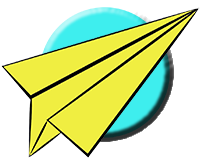Trireme Paper Airplane, step-by-step Instructions
Trireme Paper Airplane, step-by-step Instructions
Instructions
1. Fold the paper in half bringing the upper right corner down so it hits the lower left corner.
2. Rotate the paper around so the fold created previously is on the right.
3. Fold the paper exactly in half about its long edge. Unfold after the crease has been made.
4. Rotate the paper around so the remaining fold is at the top.
5. Fold the top edge of the paper down so the top middle point hits the center line crease. The new crease should be parallel to the top edge of the paper and about one finger width down from the top edge. This crease will determine the overall wing area and can be adjusted up or down depending on paper weight.
6. Fold the top edge over the top of itself. Be sure the new crease is parallel to the top edge and is tight against the previous fold.
7. Fold the top edge over on top of itself again. Be sure the new crease is parallel to the top edge and is tight against the previous fold.
8. Fold the paper exactly in half about the existing center line crease. Be sure to line up the sides for good balanc
9. Rotate the paper around so the wing flaps are up and the nose points to the left.
10. Make a crease to fold the wing tip down. The left point of the new crease should be at the upper left corner and the right point should be about one finger width down from the upper right corner.
11. Flip the paper over and rotate it around so the first wing tip flap is underneath and the nose points to the right.
12. Make a crease to fold the second wing tip down. Be sure to line up the wing tip flaps so they are even.
13. Make a crease for the first wing flap. The new crease should be parallel to the bottom edge of the fuselage and should be about one finger width up from the bottom edge. The wing area can be adjusted here by making this crease higher or lower.
14. Flip the plane over and rotate it around so the first wing flap is underneath and the nose points to the left.
15. Make a crease for the second wing flap. Be sure to line up the wing flap for good balance and flying characteristics.
16. Open the wing flaps and the wing tip flaps and adjust the angles so they are even. The dihedral angle should be flat or slightly up and the wing flaps vertical.
THE THROW Launch with a flick of the wrist at any angle. After swooping and diving, it should glide out straight fi it's trimmed well. If it flutters to the ground, the wing area is too large for the weight of the paper. If it dive bombs directly to the floor, the wings are too small and the nose too heavy for the weight of the paper.
